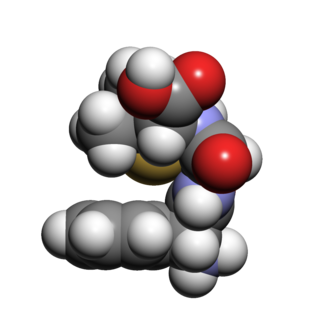
Ampicillin is an antibiotic used to prevent and treat a number of bacterial infections, such as respiratory tract infections, urinary tract infections, meningitis, salmonellosis, and endocarditis. It may also be used to prevent group B streptococcal infection in newborns. It is used by mouth, by injection into a muscle, or intravenously. Common side effects include rash, nausea, and diarrhea. It should not be used in people who are allergic to penicillin. Serious side effects may include Clostridium difficile colitis or anaphylaxis. While usable in those with kidney problems, the dose may need to be decreased. Its use during pregnancy and breastfeeding appears to be generally safe.

Amoxicillin is an antibiotic medication used to treat a number of bacterial infections. These include middle ear infection, strep throat, pneumonia, skin infections, and urinary tract infections among others. It is taken by mouth, or less commonly by injection.
Micronization is the process of reducing the average diameter of a solid material's particles. Traditional techniques for micronization focus on mechanical means, such as milling and grinding. Modern techniques make use of the properties of supercritical fluids and manipulate the principles of solubility.

Carbenicillin is a bactericidal antibiotic belonging to the carboxypenicillin subgroup of the penicillins. It was discovered by scientists at Beecham and marketed as Pyopen. It has Gram-negative coverage which includes Pseudomonas aeruginosa but limited Gram-positive coverage. The carboxypenicillins are susceptible to degradation by beta-lactamase enzymes, although they are more resistant than ampicillin to degradation. Carbenicillin is also more stable at lower pH than ampicillin.

Hetacillin is a beta-lactam antibiotic that is part of the aminopenicillin family. It is a prodrug and has no antibacterial activity itself, but quickly splits off acetone in the human body to form ampicillin, which is active against a variety of bacteria.
Ampicillin/sulbactam is a fixed-dose combination medication of the common penicillin-derived antibiotic ampicillin and sulbactam, an inhibitor of bacterial beta-lactamase. Two different forms of the drug exist. The first, developed in 1987 and marketed in the United States under the brand name Unasyn, generic only outside the United States, is an intravenous antibiotic. The second, an oral form called sultamicillin, is marketed under the brand name Ampictam outside the United States, and generic only in the United States. Ampicillin/sulbactam is used to treat infections caused by bacteria resistant to beta-lactam antibiotics. Sulbactam blocks the enzyme which breaks down ampicillin and thereby allows ampicillin to attack and kill the bacteria.

Sulbactam is a β-lactamase inhibitor. This drug is given in combination with β-lactam antibiotics to inhibit β-lactamase, an enzyme produced by bacteria that destroys the antibiotics.

Sultamicillin, sold under the brand name Unasyn among others, is an oral form of the penicillin antibiotic combination ampicillin/sulbactam. It is used for the treatment of bacterial infections of the upper and lower respiratory tract, the kidneys and urinary tract, skin and soft tissues, among other organs. It contains esterified ampicillin and sulbactam.
A selectable marker is a gene introduced into a cell, especially a bacterium or to cells in culture, that confers a trait suitable for artificial selection. They are a type of reporter gene used in laboratory microbiology, molecular biology, and genetic engineering to indicate the success of a transfection or other procedure meant to introduce foreign DNA into a cell. Selectable markers are often antibiotic resistance genes. Bacteria that have been subjected to a procedure to introduce foreign DNA are grown on a medium containing an antibiotic, and those bacterial colonies that can grow have successfully taken up and expressed the introduced genetic material. Normally the genes encoding resistance to antibiotics such as ampicillin, chloramphenicol, tetracycline or kanamycin, etc., are considered useful selectable markers for E. coli.

Ampicillin/flucloxacillin (INNs) also known as co-fluampicil (BAN), and sold under the tradename Magnapen, is a combination drug of the two β-lactam antibiotics, ampicillin and flucloxacillin, both in equal amounts, available in a capsule and as a liquid, both taken by mouth, and as a formulation which can be given by injection into muscle or vein.

The ureidopenicillins are a group of penicillins which are active against Pseudomonas aeruginosa.

Pivampicillin is a pivaloyloxymethyl ester of ampicillin. It is a prodrug, which is thought to enhance the oral bioavailability of ampicillin because of its greater lipophilicity compared to that of ampicillin.
Enterococcus faecium is a Gram-positive, gamma-hemolytic or non-hemolytic bacterium in the genus Enterococcus. It can be commensal in the gastrointestinal tract of humans and animals, but it may also be pathogenic, causing diseases such as neonatal meningitis or endocarditis.
Mycobacterium psychrotolerans is a rapidly growing mycobacterium first isolated from pond water near a uranium mine in Spain. It was able to grow at 4°C and is therefore considered to be psychrotolerant. Etymology: psychros, cold; tolerans, tolerating.

The Beecham Group plc was a British pharmaceutical company. It was once a constituent of the FTSE 100 Index. Beecham, after having merged with American pharmaceutical company SmithKline Beckman to become SmithKline Beecham, merged with Glaxo Wellcome to become GlaxoSmithKline (GSK). GSK still uses the Beechams brand name in the UK for its over-the-counter cold and flu relief products.

Bacampicillin (INN) is a penicillin antibiotic. It is a prodrug of ampicillin with improved oral bioavailability.

Ciclacillin (INN) or cyclacillin (USAN), trade names Cyclapen, Cyclapen-W, Vastcillin, and others, is an aminopenicillin antibiotic. Its spectrum of activity is similar to that of ampicillin, although it is less susceptible to beta-lactamases than ampicillin and has much higher bioavailability. A large randomized, double-blind clinical trial published in 1978 also showed that ciclacillin is associated with significantly fewer and milder adverse effects than ampicillin; later studies seemed to confirm this improved tolerability, at least in children.

Talampicillin is a beta lactam antibiotic from the penicillin family. It is an acid stable prodrug that was administered orally. It is not approved by the FDA for use in the United States. It should be avoided in Liver diseases

The aminopenicillins are a group of antibiotics in the penicillin family that are structural analogs of ampicillin. Like other penicillins and beta-lactam antibiotics, they contain a beta-lactam ring that is crucial to its antibacterial activity.
ATCvet code QG51Antiinfectives and antiseptics for intrauterine use is a therapeutic subgroup of the Anatomical Therapeutic Chemical Classification System for veterinary medicinal products, a system of alphanumeric codes developed by the World Health Organization (WHO) for the classification of drugs and other medical products for veterinary use. Subgroup QG51 is part of the anatomical group QG Genito-urinary system and sex hormones.













